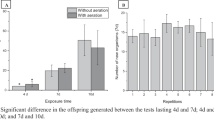Abstract
Laboratory studies were conducted to determine the effects of different concentrations of pyrimethinal on protein contents, and some oxidative stress in Tubifex tubifex after an exposure of 2, 4, and 7 days. Residues of the fungicide were followed in water and in the worms. In water, pyrimethinal concentration decreased slowly (maximum −6.4 % ± 0.8 % after 2 days for 25 mg L−1). In the worms, it increased after 4 days and decreased thereafter. LC50 values were between 49.2 ± 0.58 and 39.5 ± 0.95 mg L−1 depending on exposure time. The activity of catalase increased in response to the fungicide after 2 days of exposure to 25 mg L−1 of pyrimethinal (+90 %). The highest decrease of glutathione-S-transferase activity (−29.7 %) was found after 7 days in the presence of 25 mg L−1.
Similar content being viewed by others
References
Almar MM, Mayans JD, Rmero FJ (1987) Glutathion content and GSH S-transferase activity in mid gut gland of Procambarus clarkii, sex difference, the effect of fasting and their implications in cadmium toxicity. Comp Biochem Phys 87C:433–440
Anderson ME, Luo JL (1998) Glutathione therapy: from pro drugs to genes. Semin Liver Dis 41:1309–1319
Anderson C, Brumhard B, Ditgens K, Reiner H (1999) Metabolism of fenhexamid (KBR 2738) in plants, animals, and the environment. Pflanzenschutz Nachr Bayer 52:227–251
Bradford MN (1976) A rapid and sensitive method for the quantitation of micrograms of protein utilizing the principle of protein-dye binding. Anal Biochem 72:248–254
Claiborne A (1985) Catalase activity. In: Greenwald RA (ed) Handbook of methods in oxygen radical research. CRC Press, Boca-Raton, pp 283–284
Cossu C, Doyotte A, Jacquin MC, Vasseur P (1997) Biomarqueurs du stress oxydant chez les animaux aquatiques. In: Lagadic L, Caquet T, Amiard JC, Ramade F (eds) Biomarqueurs en Ecotoxicologie: Aspects Fondamentaux. Masson, Paris, pp 149–161
Davies JM, Lowry CV, Davies KJA (1994) Free radicals. In: Nohl H, Esterbauer H, Rice-Evans C (eds) Environment medicine and toxicology. Richelieu Press, London, pp 563–578
Egeler P, Rombke M, Meller M, Knacker T, Franke C, Studinger G, Nagel R (1997) Bioaccumulation of lindane and hexachlorobenzene by tubifcid sludge worms (Oligochaeta) under standardized laboratory conditions. Chemosphere 35:835–852
Gillis BL, Diener LC, Reynoldson TR, Dixon DG (2002) Cadmium-induced production of a metallothionein like protein in Tubifex tubifex (Oligochaeta) and Chironomus riparius (Diptera): correlation with reproduction and growth. Environ Toxicol Chem 21:1836–1844
Gillis PL, Reynoldson TB, Dixon DG (2004) Natural variation in a metallothionein-like protein in Tubifex tubifex in the absence of metal exposure. Ecotoxicol Environ Saf 58:22–28
Hazarika A, Sarkar SN (2001) Effect of isoproturon pretreatment on the biochemicaltoxicodynamics of anilofos in male rats. Toxicology 165:87–95
Lagauzère S, Boyer P, Stora G, Bonzom JM (2009) Effects of uranium-contaminated sediments on the bioturbation activity of Chironomus riparius larvae (Insecta, Diptera) and Tubifex tubifex worms (Annelida, Tubificidae). Chemosphere 76:324–334
Lucan-Bouché ML, Biagianti-Risbourg S, Arsac F, Vernet G (1999) An original decontamination process developed by the aquatic oligochaete Tubifex tubifex exposed to copper and lead. Aquat Toxicol 45:9–17
Maestre Z, Martinez-Madrid M, Rodriguez P (2009) Monitoring the sensitivity of the oligochaete Tubifex tubifex in laboratory cultures using three toxicants. Ecotoxicol Environ Saf 72:2083–2089
Mosleh YY, Ismail SS, Ahmed MT, Ahems YM (2003a) Comparative toxicity and biochemical responses of certain pesticides on mature eartworms Aporrectodea caliginosa under laboratory conditions. Environ Toxicol 18:338–346
Mosleh YY, Paris-Palacios S, Couderchet M, Vernet G (2003b) Effects of the herbicide isoporoturon on survival, growth rate, and protein content of mature earthworms (Lumbricus terrestris L.) and its fate in the soil. Appl Soil Ecol 23:69–77
Mosleh YY, Paris-Palacios S, Arnoult A, Couderchet M, Biagianti-Risbourg S, Vernet G (2004) Metallothionein induction in the aquatic Oligocheate Tubifex tubifex exposed to the herbicide isoproturon. Environ Toxicol 19:88–93
Mosleh YY, Paris-Palacios S, Couderchet M, Biagianti-Risbourg S, Vernet G (2005) Effects of the herbicide isoproturon on metallothioneins, growth and antioxidative defences in the aquatic worm Tubifex tubifex (Oligochaeta, Tubificidae). Ecotoxicology 14:1–13
Mosleh YY, Paris-Palacios S, Biagianti-Risbourg S (2006) Metallothioneins induction and antioxidative response in aquatic worms Tubifex tubifex (Oligochaeta, Tubificidae) exposed to copper. Chemosphere 64:121–128
Mosleh YY, Paris-Palacios S, Mohamed TA, Mahmoud F, Osman MA, Biagianti-Risbourg S (2007) Effects of chitosan on oxidative stress and metallothioneins in aquatic worm Tubifex tubifex (Oligochaeta, Tubifcidae). Chemosphere 67:167–175
Organisation for Economic Co-operation and Development (OECD) (1984) Earthworm, acute toxicity test. Guideline No. 207. Organisation for Economic Co-operation and Development, Paris
Paris-Palacios S, Mosleh Y, Mohamad A, Laurence DT, Conrad A, Arnoult F, Biagianti-Risbourg S (2010) Toxic effects and bioaccumulation of the herbicide isoproturon in Tubifex tubifex (Oligocheate, Tubificidae): a study of significance of autotomy and its utility as a biomarker. Aquat Toxicol 98:8–14
Regoli F, Nigro M, Bertoli E, Principato J, Orlando E (1997) Defences against oxidative stress in the Antartic scallop Adamussium colbecki and effects of acute exposure to metals. Hydrobiologia 355:139–144
Ribeiro S, Sousa JP, Noguerira AJ, Soares AM (2001) Effect of endosulfan and parathion on energy reserves and physiological parameters of the terrestrial isopod Porcellio dilatatus. Ecotoxicol Environ Saf 49:131–138
Saravana-Bhavan P, Geraldine P (2000) Aberration in various parameters of bioenergetic in the Macrobarchium malcomsonii following exposure to endosulfan. Aquaculture 1:141–150
Saravana-Bhavan P, Geraldine P (2001) Biochemical stress responses in tissues of the prawn Macrobarchium malcomsonii on exposure to endosulfan. Pestic Biochem Phys 70:27–41
Widianarko B, Van Straalen N (1996) Toxicokinetics-based survival analysis in bioassays using non-persistent chemicals. Environ Toxicol Chem 15:402–406
Author information
Authors and Affiliations
Corresponding author
Rights and permissions
About this article
Cite this article
Mosleh, Y.Y., Mofeed, J., Afifi, M. et al. Biological Effects of Pyrimethinal on Aquatic Worms (Tubifex tubifex) Under Laboratory Conditions. Bull Environ Contam Toxicol 92, 85–89 (2014). https://doi.org/10.1007/s00128-013-1153-x
Received:
Accepted:
Published:
Issue Date:
DOI: https://doi.org/10.1007/s00128-013-1153-x




